Spatiotemporal Distribution and Driving Factors of Historic and Cultural Villages in China
Abstract
1. Introduction
2. Research Data and Methods
2.1. Overview of the Study Area
2.2. Data Sources
2.3. Research Framework
2.4. Research Methods
2.4.1. Independent Samples t-Test
2.4.2. Nearest Neighbor Index
2.4.3. Moran’s I Analysis
2.4.4. Kernel Density Analysis
2.4.5. Standard Deviational Ellipse
2.4.6. Selection of Influencing Factors and Indicator System Construction
2.4.7. Geographic Detector
3. Results Analysis
3.1. Spatiotemporal Evolution of Historic and Cultural Villages
3.1.1. Spatial Distribution Characteristics
3.1.2. Spatial Clustering Characteristics
3.1.3. Centroid Migration Trajectory
3.2. Factors Influencing the Spatial Distribution of Historic and Cultural Villages
3.2.1. Physical Geography
- (1)
- Elevation
- (2)
- Slope and Aspect
- (3)
- Temperature and Precipitation
- (4)
- River Systems
3.2.2. Socioeconomic Factors
3.2.3. Transportation Networks
3.2.4. Visitor Market
- (1)
- Population Density
- (2)
- Proximity to Administrative Cities
3.2.5. Tourism Resources
- (1)
- 5A-Rated Scenic Areas
- (2)
- Nighttime Light Intensity
- (3)
- Accommodation Facilities
3.2.6. Comparison of Influencing Factors
4. Discussion
4.1. Factors Influencing the Spatial Distribution of Historic and Cultural Villages in China
4.1.1. Natural Geography
4.1.2. Socioeconomic Conditions
4.1.3. Transportation Accessibility
4.1.4. Tourist Market
4.1.5. Tourism Resources
4.2. Comparison with Other Countries
4.3. Policy Implications
5. Conclusions
Author Contributions
Funding
Data Availability Statement
Acknowledgments
Conflicts of Interest
Abbreviations
| villages | Historic and cultural villages |
| GIS | Geographic Information Systems |
| MCDA | Multi-Criteria Decision Analysis |
| NNI | Nearest neighbor index |
| SDE | Standard deviational ellipse |
Appendix A
| Name | Identification Department | Features |
|---|---|---|
| China’s Historic and Cultural Villages | Ministry of Housing and Urban-Rural Development (MOHURD) and the National Cultural Heritage Administration (NCHA) | Historic and Cultural Villages refer to villages that preserve exceptionally rich cultural relics, possess significant historical value or commemorative importance, and can relatively completely reflect the traditional architectural features and local ethnic characteristics of a specific historical period. Their core resources include cultural and historical assets such as heritage buildings, ancient streets and alleys, historic environmental elements, and intangible cultural heritage, endowing them with prominent cultural status and value. Compared to Traditional Villages, Historic and Cultural Villages are assigned a higher conservation tier for cultural resources and are subject to more stringent protection requirements. |
| China’s Historic and Cultural Towns | Ministry of Housing and Urban-Rural Development (MOHURD) and the National Cultural Heritage Administration (NCHA) | China’s Historic and Cultural Towns are designated through a joint selection process by the Ministry of Housing and Urban-Rural Development (MOHURD) and the National Cultural Heritage Administration (NCHA). These towns preserve exceptionally rich cultural relics, possess significant historical value or commemorative importance, and are capable of fully reflecting the traditional architectural features and local ethnic characteristics of specific historical periods. |
| China’s Historic and Cultural Cities | Ministry of Housing and Urban-Rural Development (MOHURD) and the National Cultural Heritage Administration (NCHA) | China’s Historic and Cultural Cities refer to urban areas that preserve exceptionally rich cultural relics and possess significant historical, cultural, or revolutionary significance. In terms of administrative divisions, such designated areas are not necessarily “cities” in the modern municipal sense—they may also be designated at the county or district level while still carrying the title “Historic and Cultural City” as a national recognition of their heritage value. |
| Chinese Traditional Village | Ministry of Housing and Urban-Rural Development (MOHURD) | Traditional Villages represent a treasury of historical information and cultural landscapes, serving as the most significant legacy of China’s agrarian civilization. These villages retain considerable historical continuity, with their built environment, architectural features, and settlement layout remaining largely unchanged over time. They possess unique folk customs and traditions, and despite their great antiquity, continue to be vibrant, functioning communities. This highlights their profound civilizational value and enduring legacy of cultural transmission. |
| Technical Type | Uniqueness | Applicability | Limitations |
|---|---|---|---|
| Geographically Weighted Regression (GWR) | 1. GWR accounts for spatial heterogeneity by analyzing local relationships between variables. 2. It is supported by a well-established theoretical foundation and offers a wide range of statistical testing methods. | 1. Suitable for analyzing the distribution characteristics of spatial data, spatial relationships between variables, and spatial dependence, among other aspects. 2. Commonly used in fields such as regional economics, urban planning, and ecology to address issues involving spatial data analysis. | 1. Geographically Weighted Regression (GWR) has certain limitations in handling multi-factor interactions. 2. It imposes specific requirements on data quality and distribution, such as the assumption of spatial stationarity. |
| Multi-Criteria Decision Analysis (MCDA) Models | 1. MCDA models enable comprehensive consideration of multiple evaluation criteria and facilitate decision analysis through weight assignment. 2. They offer robust spatial visualization capabilities to intuitively present analytical results. | 1. MCDA models are suitable for addressing geographical issues involving multi-objective decision-making, such as land-use planning and site selection analysis. 2. They can be integrated with other data and methods to construct complex geographical analysis models. | 1. The weight determination process in MCDA models is highly subjective, which may impact the accuracy of results. 2. Model validation and calibration are challenging, requiring high data precision and resolution. |
| Machine Learning Algorithms | 1. Random Forest can handle high-dimensional data with strong resistance to overfitting; Support Vector Machine (SVM) achieves effective classification and regression results even with small-sample data. 2. Capable of automated feature selection to uncover underlying patterns in data. | 1. Suitable for tasks such as classification, regression, and prediction of geographical data, including land use classification and climate change forecasting. 2. Offers advantages in handling complex nonlinear relationships. | 1. Machine learning algorithms are often regarded as “black-box” models, with relatively poor interpretability of results. 2. Require large volumes of high-quality data and involve complex data preprocessing procedures. |
| Geodetector | 1. Capable of effectively identifying non-linear interactions among multiple factors, enabling in-depth analysis of synergistic or inhibitory relationships between variables. 2. Relatively flexible data distribution requirements, without the need to meet strict statistical assumptions. | 1. Suitable for investigating the driving mechanisms behind geographical spatial heterogeneity, particularly advantageous in analyzing the effects of multiple factors within complex geographical systems. 2. Applicable to geographical studies at various scales (e.g., global, national, regional, local) and capable of processing diverse data types (e.g., numerical, categorical). | 1. Sensitive to missing data, requiring rigorous data preprocessing. 2. Interpretation of results is relatively complex and necessitates in-depth analysis supported by domain-specific knowledge. |
References
- National Government Services Platform. Available online: https://gjzwfw.www.gov.cn/index.html (accessed on 2 February 2025).
- Agnoletti, M. Rural landscape, nature conservation and culture: Some notes on research trends and management approaches from a (southern) European perspective. Landsc. Urban Plan. 2014, 126, 66–73. [Google Scholar] [CrossRef]
- UNESCO. Available online: https://www.unesco.org/en/search?category=UNESCO&query=Cultural+landscape (accessed on 2 February 2025).
- Yachen, C.; Jinye, L. Thinking on the evolution path of the intangible cultural heritage protection system around the world. Econ. Geogr. 2022, 42, 225–230. [Google Scholar]
- Yang, G. Holistic Spatial Characteristics of Historical and Cultural Villages and Their Sociological Significances. In Rebirth of Historical Cultural Village in China; Tongji University Press: Shanghai, China, 2024. [Google Scholar]
- Piech, I.; Dacko, A. Landscape unit as an element of digital cultural heritage: Theory and concepts on the example of Czuów. Geomat. Landmanag. Landsc. 2025, 1, 77–92. [Google Scholar] [CrossRef]
- Hussein, A.S.; El-Shishiny, H. Wind flow modeling and simulation over the Giza Plateau cultural heritage site in Egypt. J. Comput. Cult. Heritage 2009, 2, 1–22. [Google Scholar] [CrossRef]
- Ghosh, S.; Pillai, R.H.; Roy, A.; Anand Murali, R.; Vardhan, V. A simulation study of dust transport on an ancient amphitheatre: The Delphi example. J. Cult. Herit. 2017, 24, 108–116. [Google Scholar] [CrossRef]
- Convention Concerning the Protection of the World Cultural and Natural Heritage. Available online: https://www.un.org/zh/documents/treaty/whc (accessed on 3 February 2025).
- Zhu, J.; Xu, W.; Xiao, X.Y. Bingwen Temporal and spatial patterns of traditional village distribution evolution in Xiangxi, China: Identifying multidimensional influential factors and conservation significance. Herit. Sci. 2023, 11, 1–19. [Google Scholar] [CrossRef]
- Shummadtayar, U.; Iamtrakul, P.; Kazunori, H. Community-Based Tourism Mechanism Networks: A Factor for Sustainable Tourism at The World Heritage Corridor in Thailand. J. Southeast Asian Stud. 2024, 29, 27–45. [Google Scholar] [CrossRef]
- Chen, H.; Xiao, D.; Li, J.; Liu, Y. Study on the distribution characteristics and formation mechanism of traditional village names in Southeast Guizhou. npj Herit. Sci. 2025, 13, 1–25. [Google Scholar] [CrossRef]
- Ding, C.; Zhao, Y. Spatial patterns, factor identification, and ethnic differences: A study of traditional villages in the Yuan River Basin based on geographical detectors. Humanit. Soc. Sci. Commun. 2025, 12, 1–15. [Google Scholar] [CrossRef]
- Yan, H.; Dong, R.; He, Y.; Qi, J.; Li, L. Spatial Agglomeration Differences of Amenities and Causes in Traditional Villages from the Perspective of Tourist Perception. Sustainability 2025, 17, 4475. [Google Scholar] [CrossRef]
- Altaba, P.; García-Esparza, J.A. A Practical Vision of Heritage Tourism in Low-Population-Density Areas. The Spanish Mediterranean as a Case Study. Sustainability 2021, 13, 5144. [Google Scholar] [CrossRef]
- Guo, Z.; Sun, L. The planning, development and management of tourism: The case of Dangjia, an ancient village in China. Tour. Manag. 2016, 56, 52–62. [Google Scholar] [CrossRef]
- Chen, L.; Zhong, Q.; Li, Z. Analysis of spatial characteristics and influence mechanism of human settlement suitability in traditional villages based on multi-scale geographically weighted regression model: A case study of Hunan province. Ecol. Indic. 2023, 154, 16. [Google Scholar] [CrossRef]
- Chen, W.; Yang, L.; Wu, J.; Wu, J.; Wang, G.; Bian, J.; Zeng, J.; Liu, Z. Spatio-temporal characteristics and influencing factors of traditional villages in the Yangtze River Basin: A Geodetector model. Herit. Sci. 2023, 11, 111. [Google Scholar] [CrossRef]
- Ma, Y.; Zhang, Q.; Huang, L. Spatial distribution characteristics and influencing factors of traditional villages in Fujian Province, China. Humanit. Soc. Sci. Commun. 2023, 10, 1–17. [Google Scholar] [CrossRef]
- Liu, W.; Xue, Y.; Shang, C. Spatial distribution analysis and driving factors of traditional villages in Henan province: A comprehensive approach via geospatial techniques and statistical models. Herit. Sci. 2023, 11, 185. [Google Scholar] [CrossRef]
- Wang, X.; Zhang, T.; Duan, L.; Liritzis, I.; Li, J. Spatial distribution characteristics and influencing factors of intangible cultural heritage in the Yellow River Basin. J. Cult. Herit. 2024, 66, 254–264. [Google Scholar] [CrossRef]
- Athanasiou, K. The Rise and Decline of Settlement Sites and Traditional Rural Architecture on Therasia Island and Their Reciprocal Interaction with the Environment. Heritage 2024, 7, 5660–5686. [Google Scholar] [CrossRef]
- Cahyani, D.; Sudikno, A.; Fauzy, B. Examining the Spatial Pattern in Indonesia’s Villages for the Globalization Mechanism of Survival. J. Eng. Sci. Technol. 2020, 15, 30–38. [Google Scholar]
- Fallah Tafti, F.; Lee, J.H. Examining variance, flexibility, and centrality in the spatial configurations of Yazd schools: A longitudinal analysis. Buildings 2022, 12, 2080. [Google Scholar] [CrossRef]
- Ruiz-Jaramillo, J.; Munoz-Gonzalez, C.; Joyanes-Diaz, M.D.; Jimenez-Morales, E.; Lopez-Osorio, J.M.; Barrios-Perez, R.; Rosa-Jimenez, C. Heritage risk index: A multi-criteria decision-making tool to prioritize municipal historic preservation projects. Front. Arch. Res. 2020, 9, 403–418. [Google Scholar] [CrossRef]
- Wu, J.; Lu, Y.; Gao, H.; Wang, M. Cultivating historical heritage area vitality using urban morphology approach based on big data and machine learning. Comput. Environ. Urban Syst. 2022, 91, 101716. [Google Scholar] [CrossRef]
- Zhang, Z.; Song, Y.; Wu, P. Robust geographical detector. Int. J. Appl. Earth Obs. Geoinf. 2022, 109, 102782. [Google Scholar] [CrossRef]
- Zhan, C.; Liang, C.; Zhao, L.; Zhang, Y.; Cheng, L.; Jiang, S.; Xing, L. Multifractal characteristics analysis of daily reference evapotranspiration in different climate zones of China. Phys. A Stat. Mech. Appl. 2021, 583, 126273. [Google Scholar] [CrossRef]
- Standard Map Service System. Available online: http://bzdt.ch.mnr.gov.cn/ (accessed on 5 February 2025).
- National Catalogue Service for Geographic Information. Available online: https://www.webmap.cn/main.do?method=index (accessed on 5 February 2025).
- Open Street Map. Available online: https://openstreetmap.org (accessed on 7 February 2025).
- Ministry of Culture and Tourism of the People’s Republic of China. Available online: https://www.mct.gov.cn/ (accessed on 7 February 2025).
- Geospatial Data Cloud. Available online: https://www.gscloud.cn/ (accessed on 7 February 2025).
- Huang, C.; Xiao, C.; Rong, L. Integrating Point-of-Interest Density and Spatial Heterogeneity to Identify Urban Functional Areas. Remote. Sens. 2022, 14, 4201. [Google Scholar] [CrossRef]
- Xiong, C.; Ren, H.; Xu, D.; Gao, Y. Spatial scale effects on the value of ecosystem services in China’s terrestrial area. J. Environ. Manag. 2024, 366, 13. [Google Scholar] [CrossRef]
- Hambrecht, L.; Lucieer, A.; Malenovský, Z.; Melville, B.; Ruiz-Beltran, A.P.; Phinn, S. Considerations for assessing functional forest diversity in high-dimensional trait space derived from drone-based lidar. Remote. Sens. 2022, 14, 4287. [Google Scholar] [CrossRef]
- Yang, C.; Zhan, Q.; Gao, S.; Liu, H. Characterizing the spatial and temporal variation of the land surface temperature hotspots in Wuhan from a local scale. Geo-Spatial Inf. Sci. 2020, 23, 327–340. [Google Scholar] [CrossRef]
- Chen, X.; Xie, W.; Li, H. The spatial evolution process, characteristics and driving factors of traditional villages from the perspective of the cultural ecosystem: A case study of Chengkan Village. Habitat Int. 2020, 104, 102250. [Google Scholar] [CrossRef]
- Liu, H.; Huang, B.; Yang, C. Assessing the coordination between economic growth and urban climate change in China from 2000 to 2015. Sci. Total. Environ. 2020, 732, 139283. [Google Scholar] [CrossRef]
- Qi, J.; Lu, Y.; Han, F.; Ma, X.; Yang, Z. Spatial distribution characteristics of the rural tourism villages in the Qinghai-Tibetan Plateau and its influencing factors. Int. J. Environ. Res. Public Health 2022, 19, 9330. [Google Scholar] [CrossRef]
- Xu, H.; Xiao, W.; Zhang, S.; Fan, Y.; Kang, X.; Han, Y.; Zhou, T. Exploring determinants of freeway service area usage in the context of sustainable and collaborated development for transport and tourism. Transp. Res. Part A Policy Pract. 2024, 185, 104124. [Google Scholar] [CrossRef]
- Kongbuamai, N.; Zafar, M.W.; Zaidi, S.A.H.; Liu, Y. Determinants of the ecological footprint in Thailand: The influences of tourism, trade openness, and population density. Environ. Sci. Pollut. Res. 2020, 27, 40171–40186. [Google Scholar] [CrossRef]
- Xie, X.; Zhang, L.; Sun, H.; Chen, F.; Zhou, C. Spatiotemporal difference characteristics and influencing factors of tourism urbanization in China’s major tourist cities. Int. J. Environ. Res. Public Health 2021, 18, 10414. [Google Scholar] [CrossRef]
- Karimian, H.; Zou, W.; Chen, Y.; Xia, J.; Wang, Z. Landscape ecological risk assessment and driving factor analysis in Dongjiang river watershed. Chemosphere 2022, 307, 135835. [Google Scholar] [CrossRef]
- Li, D.G. William Skinner (1925–2008) andnew studies of Chinese regional history: Introduction. Chin. Stud. Hist. 2018, 51, 301–304. [Google Scholar] [CrossRef]
- Sheng, S.; Pan, H.; Ning, L.; Zhang, Z.; Xue, Q. An Examination of the Spatial Distribution Patterns of National-Level Tourism and Leisure Districts in China and Their Underlying Driving Factors. Buildings 2024, 14, 3620. [Google Scholar] [CrossRef]
- Nie, Z.; Chen, C.; Pan, W.; Dong, T. Exploring the dynamic cultural driving factors underlying the regional spatial pattern of Chinese traditional villages. Buildings 2023, 13, 3068. [Google Scholar] [CrossRef]
- Zerbe, S. Restoration of Multifunctional Cultural Landscapes: Merging Tradition and Innovation for a Sustainable Future; Springer Nature: Berlin/Heidelberg, Germany, 2022; Volume 30. [Google Scholar]
- Nocca, F. The role of cultural heritage in sustainable development: Multidimensional indicators as decision-making tool. Sustainability 2017, 9, 1882. [Google Scholar] [CrossRef]
- Mu, Q.; Aimar, F. How are historical villages changed? A systematic literature review on European and Chinese cultural heritage preservation practices in rural areas. Land 2022, 11, 982. [Google Scholar] [CrossRef]
- Angrisano, M.; Nocca, F.; Scotto Di Santolo, A. Multidimensional evaluation framework for assessing cultural heritage adaptive reuse projects: The case of the seminary in Sant’Agata de’Goti (Italy). Urban Sci. 2024, 8, 50. [Google Scholar] [CrossRef]
- Sardaro, R.; La Sala, P.; De Pascale, G.; Faccilongo, N. The conservation of cultural heritage in rural areas: Stakeholder preferences regarding historical rural buildings in Apulia, southern Italy. Land Use Policy 2021, 109, 105662. [Google Scholar] [CrossRef]
- Tuitjer, G.; Steinführer, A. The scientific construction of the village. Framing and practicing rural research in a trend study in Germany, 1952–2015. J. Rural. Stud. 2021, 82, 489–499. [Google Scholar] [CrossRef]
- Law, L.Y.; Chen, H.; Liu, S.; Cheung, M.H. Top-down rural heritage revitalization and economic development: A case study of Tangwei village, Dongguan, Guangdong, China. J. Chin. Archit. Urban 2025, 7, 5029. [Google Scholar] [CrossRef]
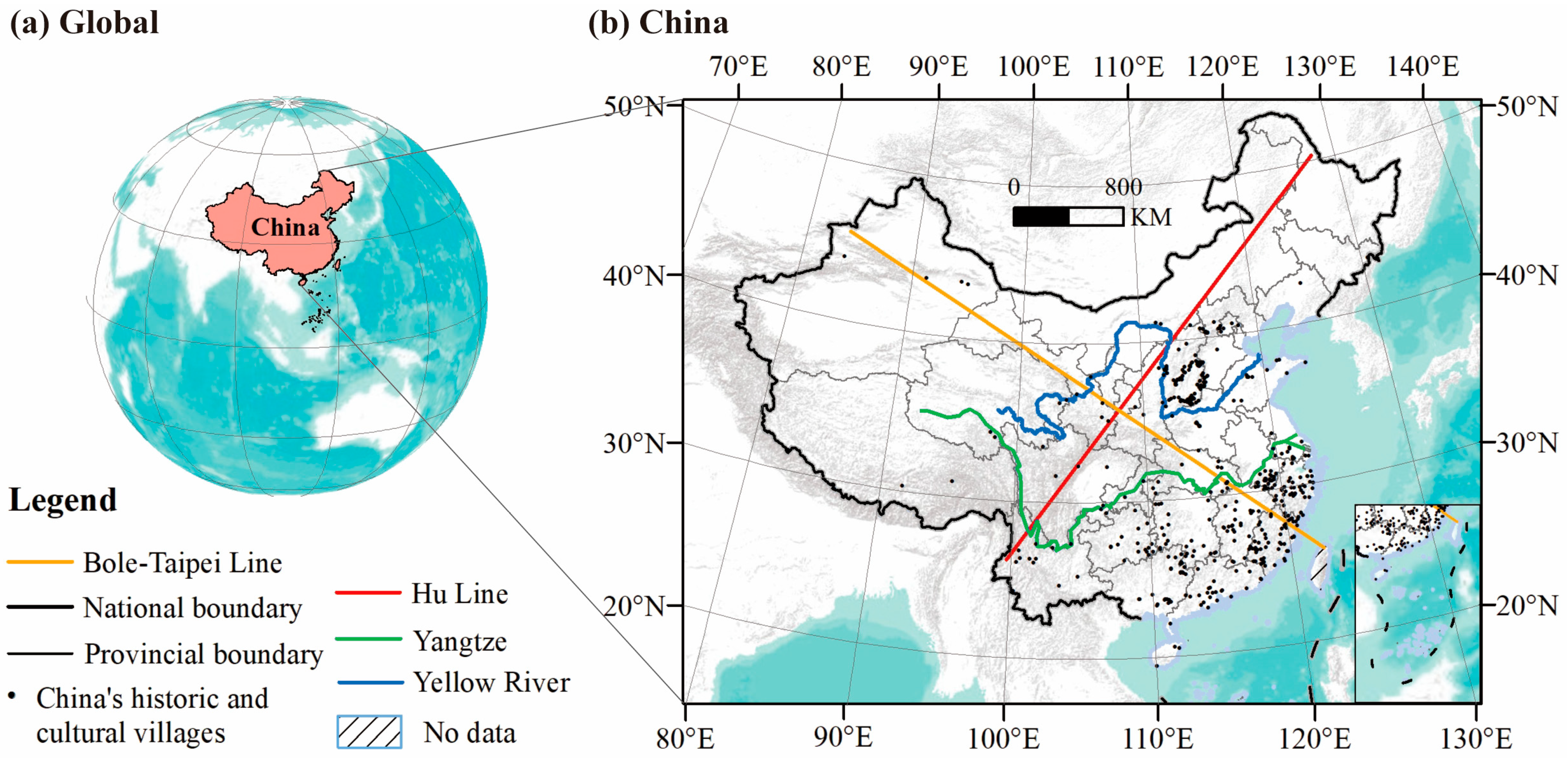
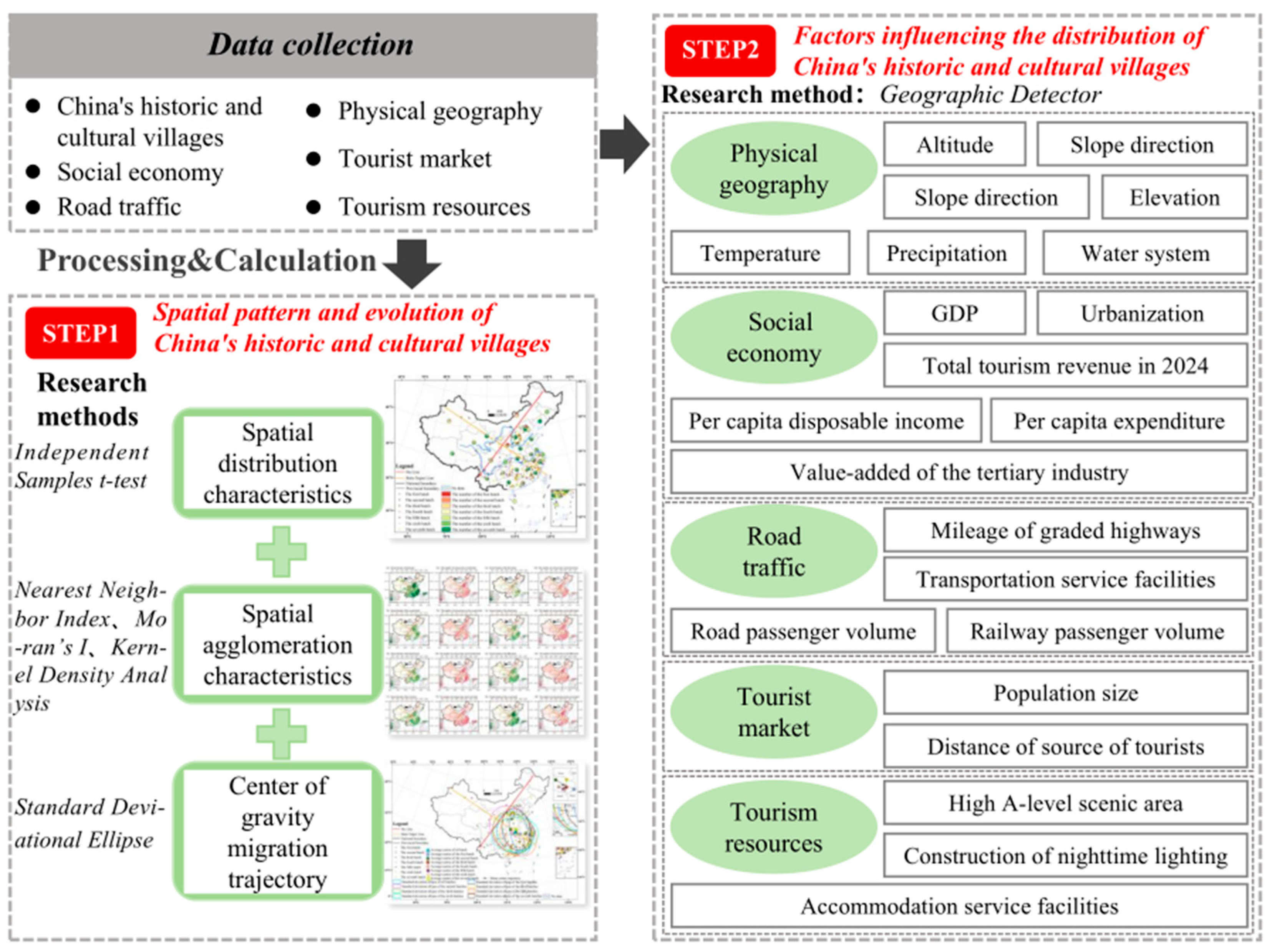
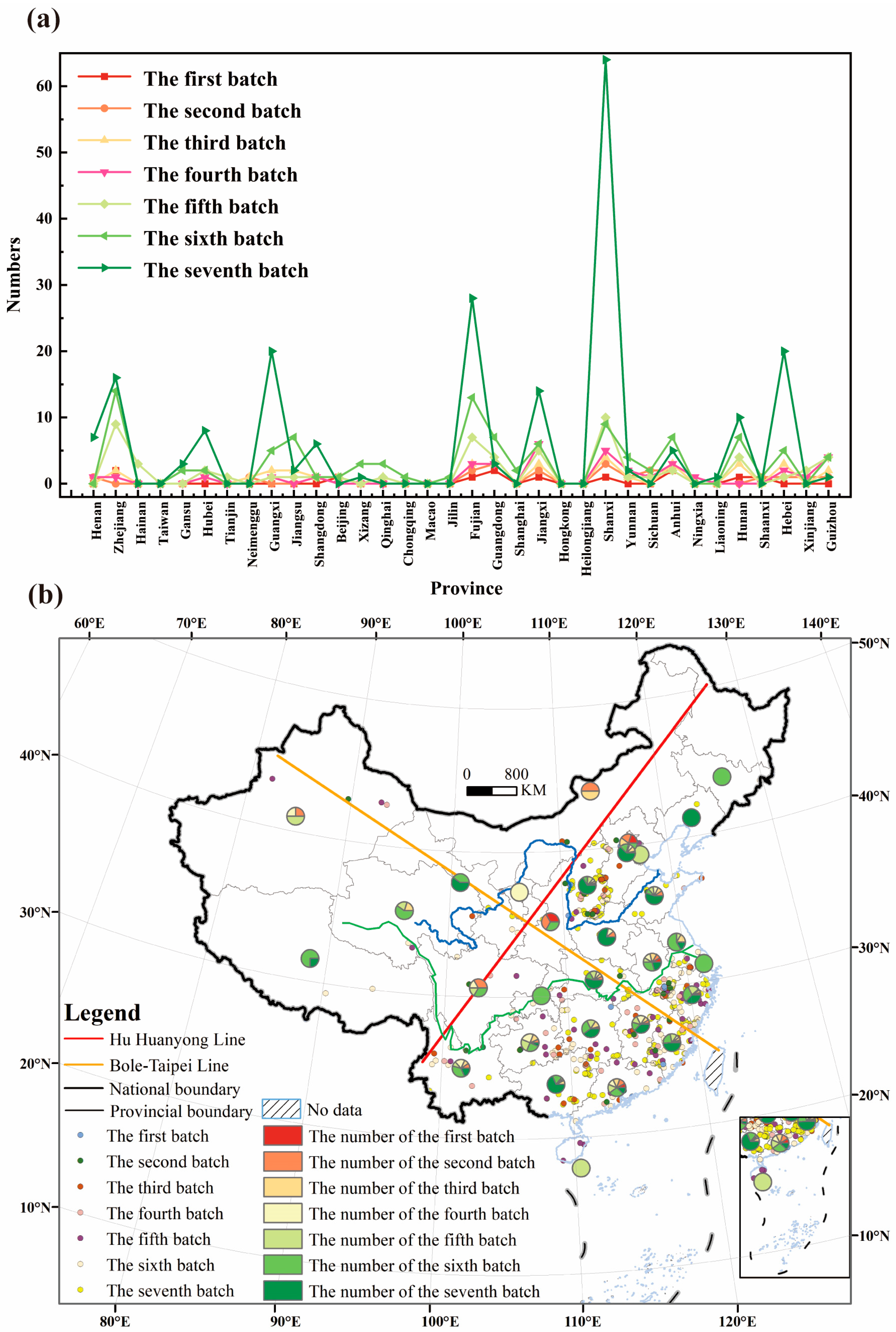
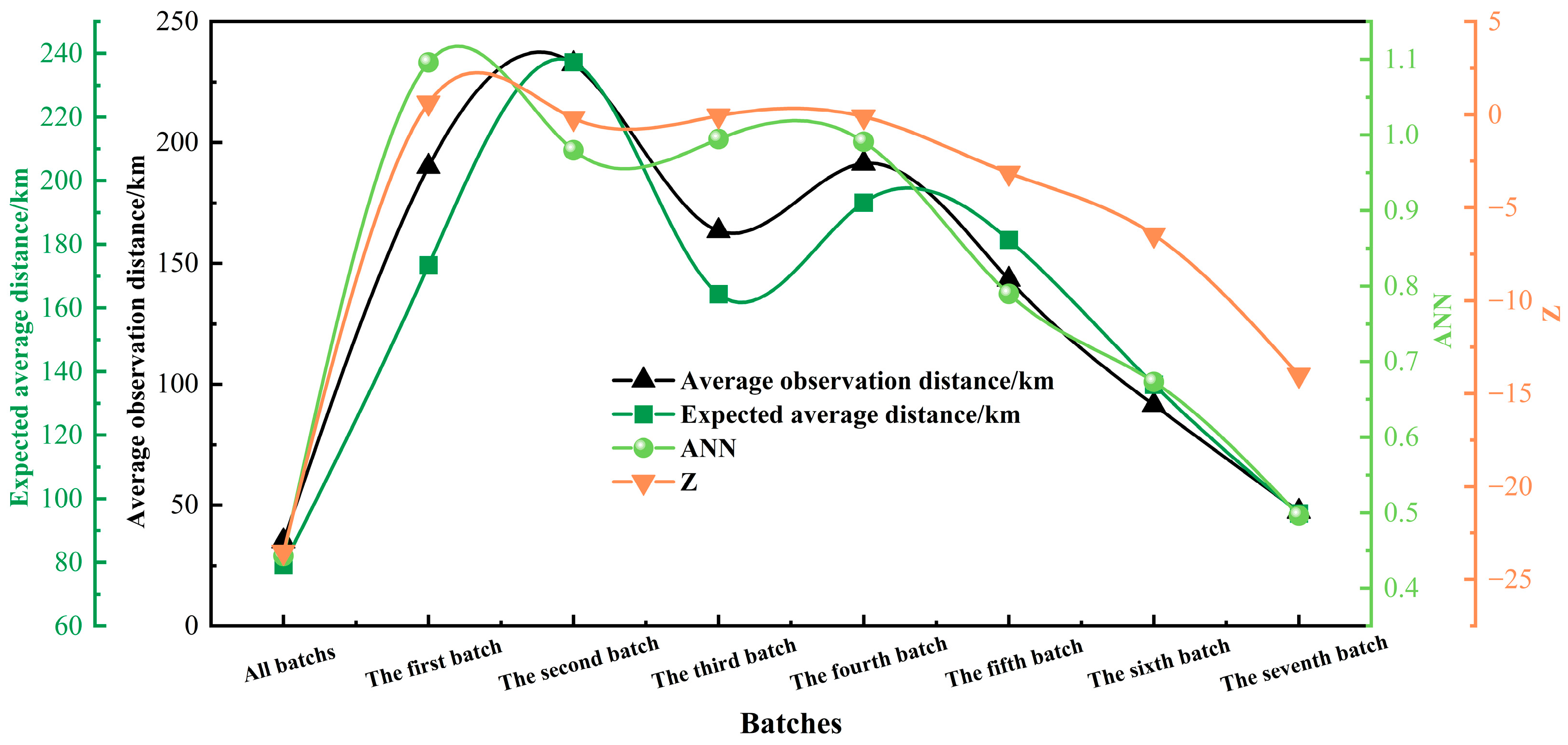
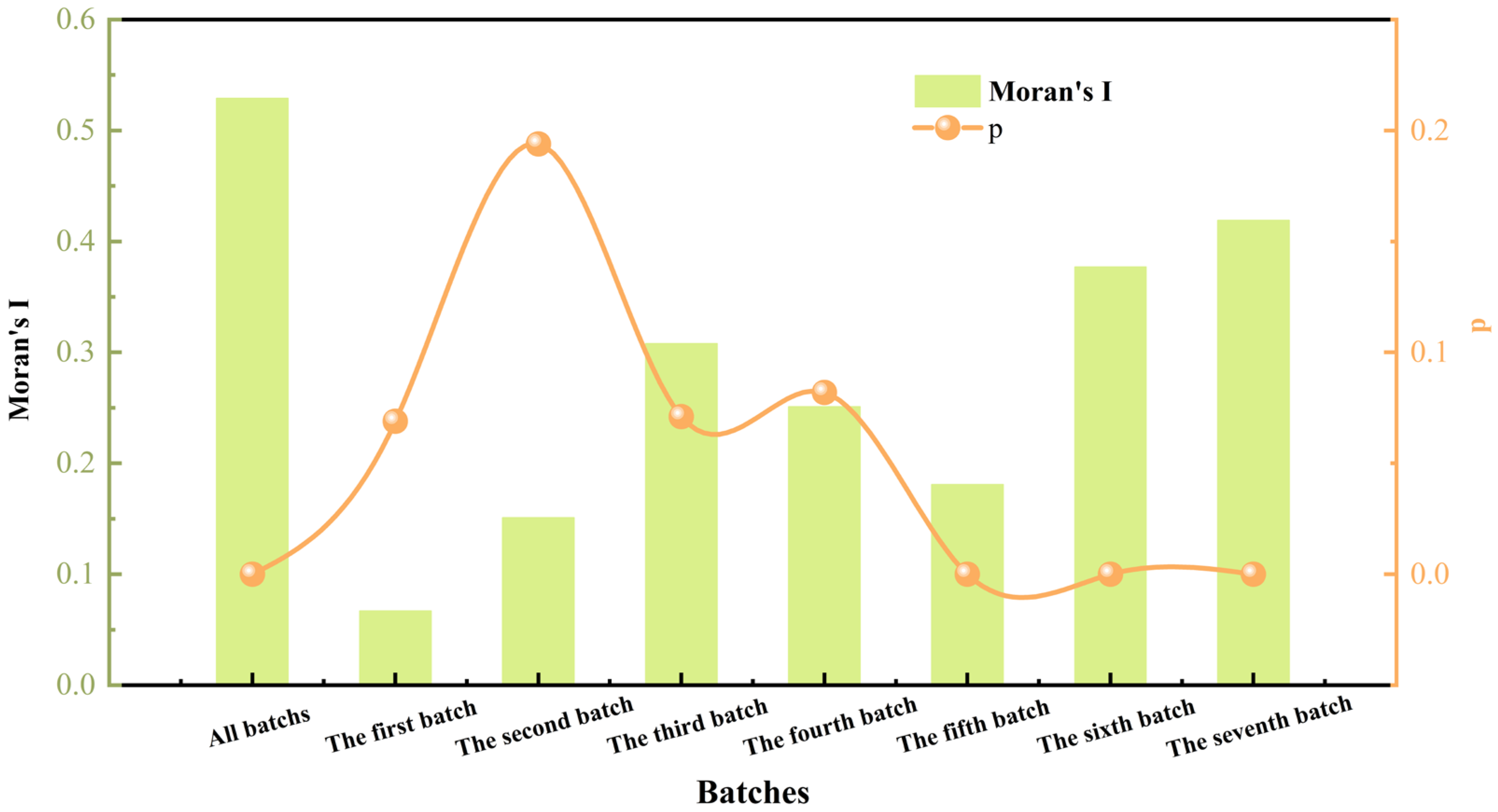
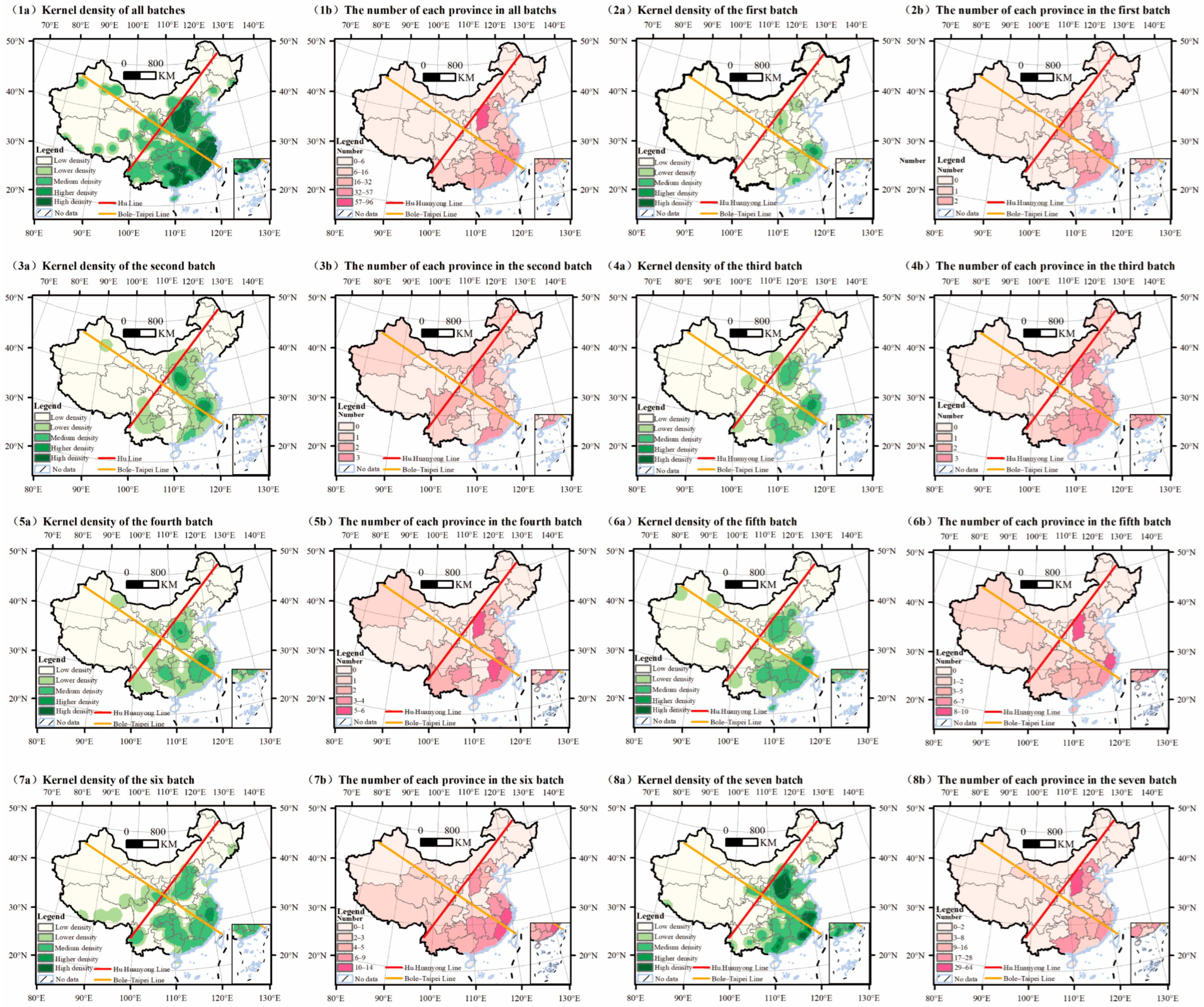
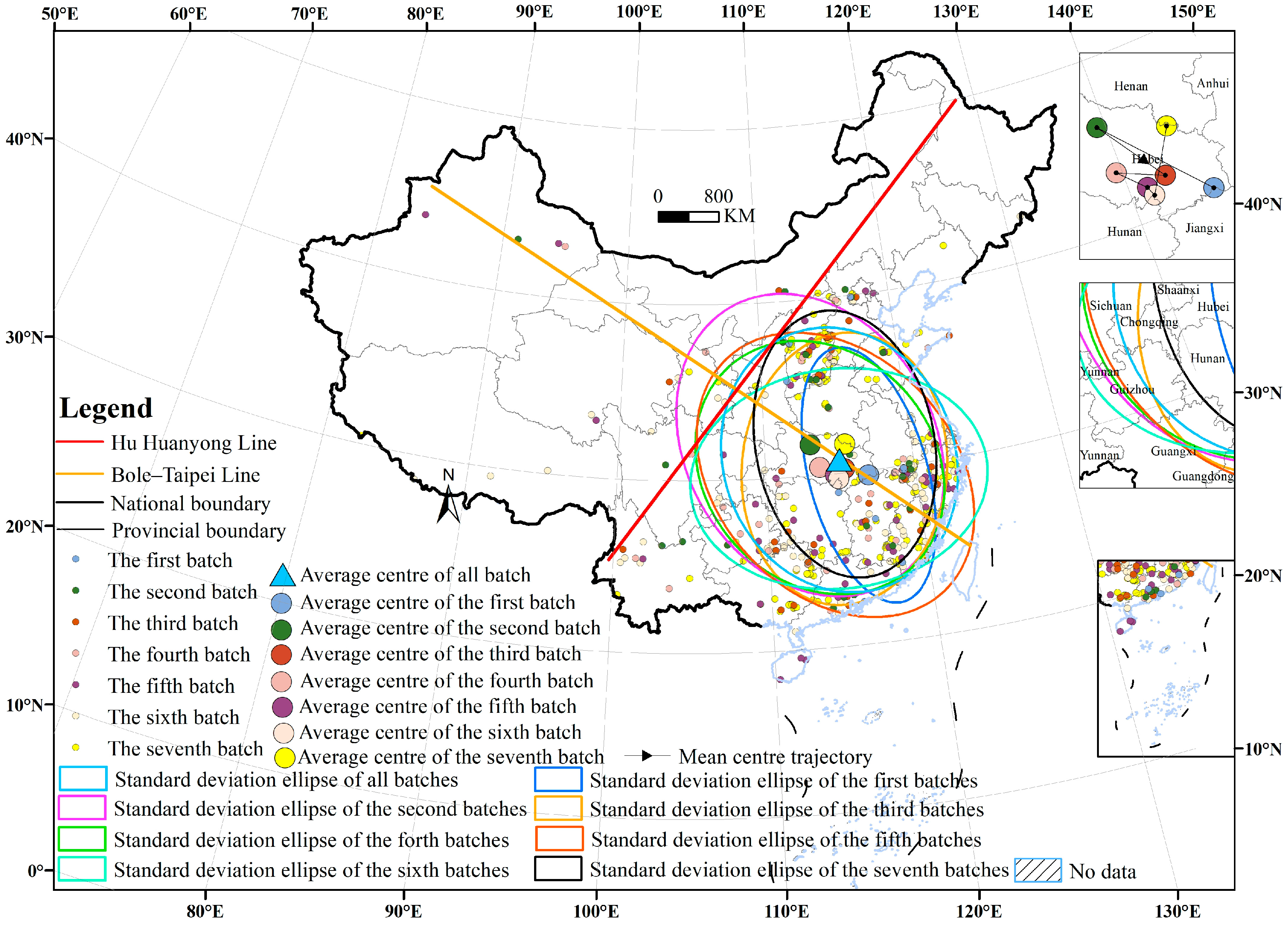
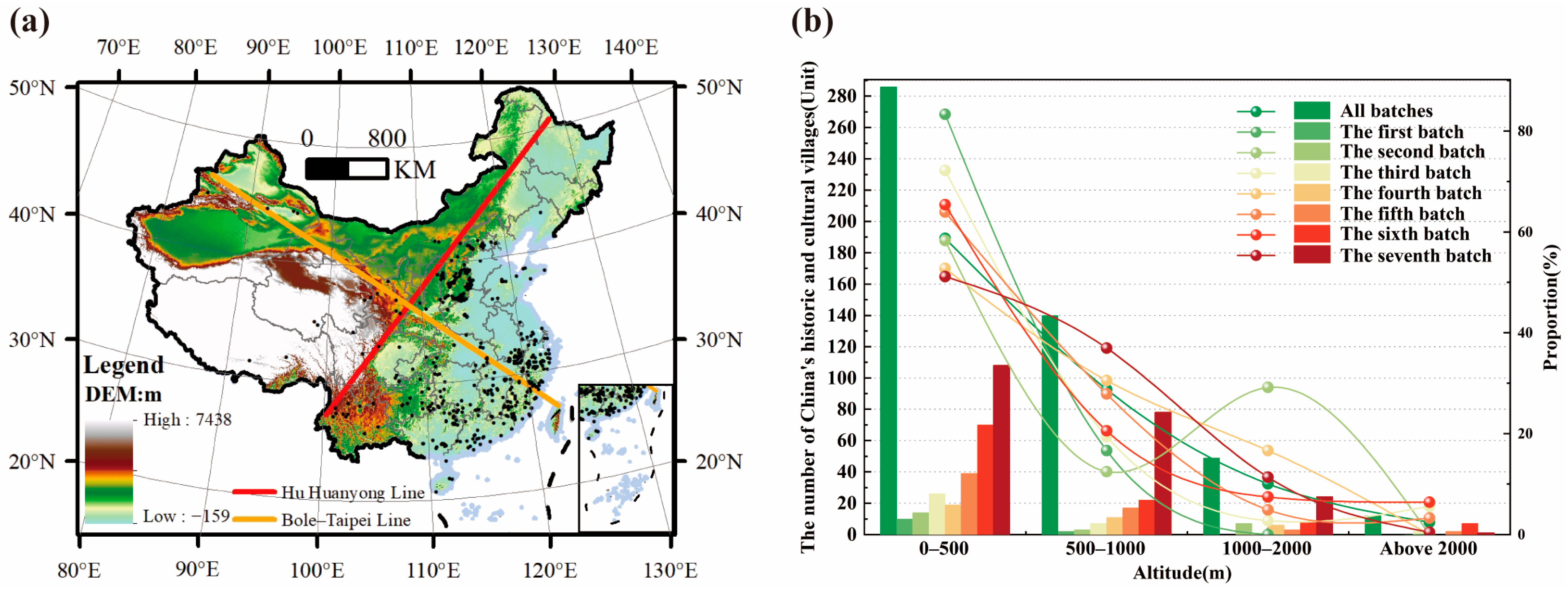
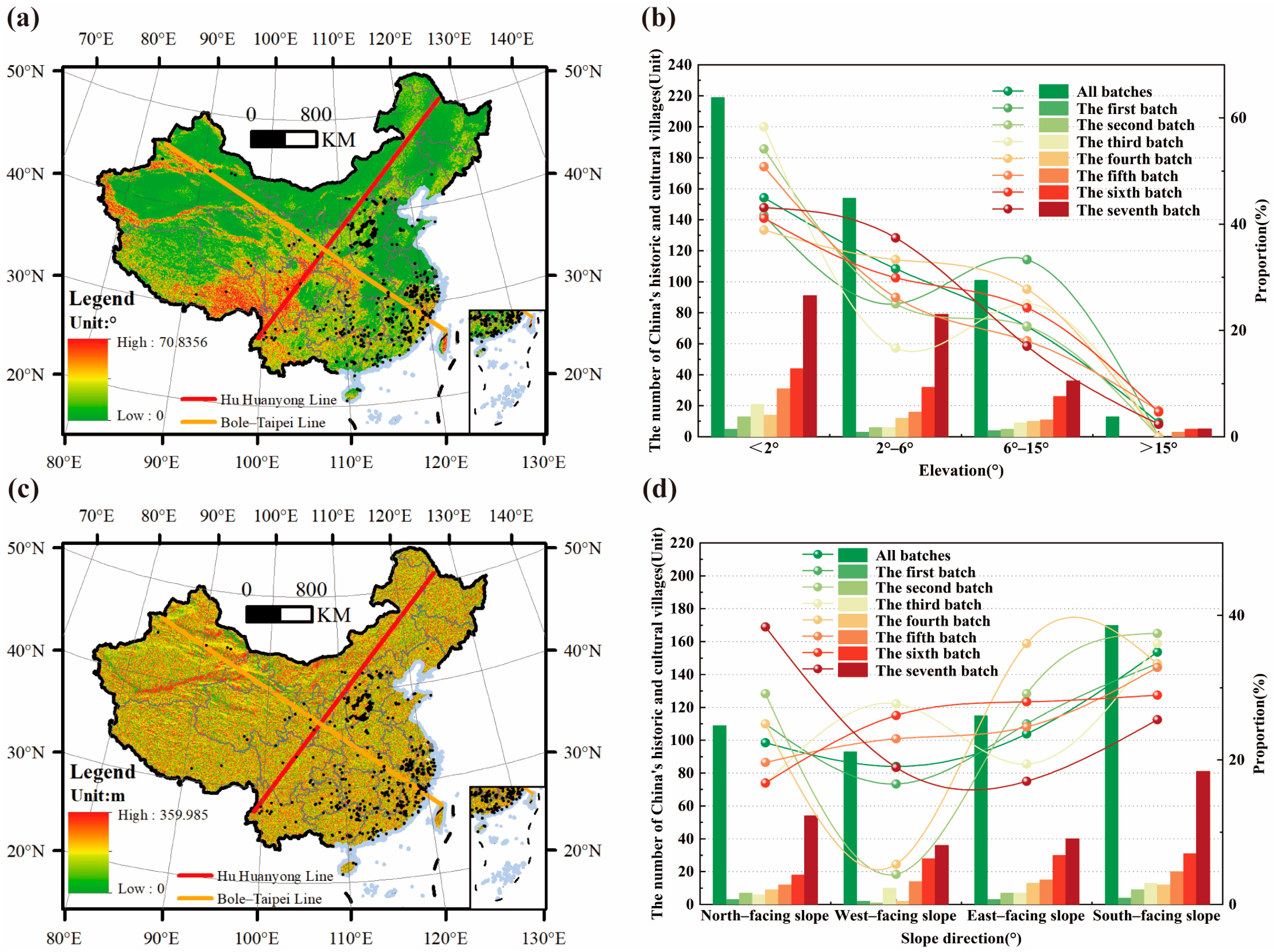
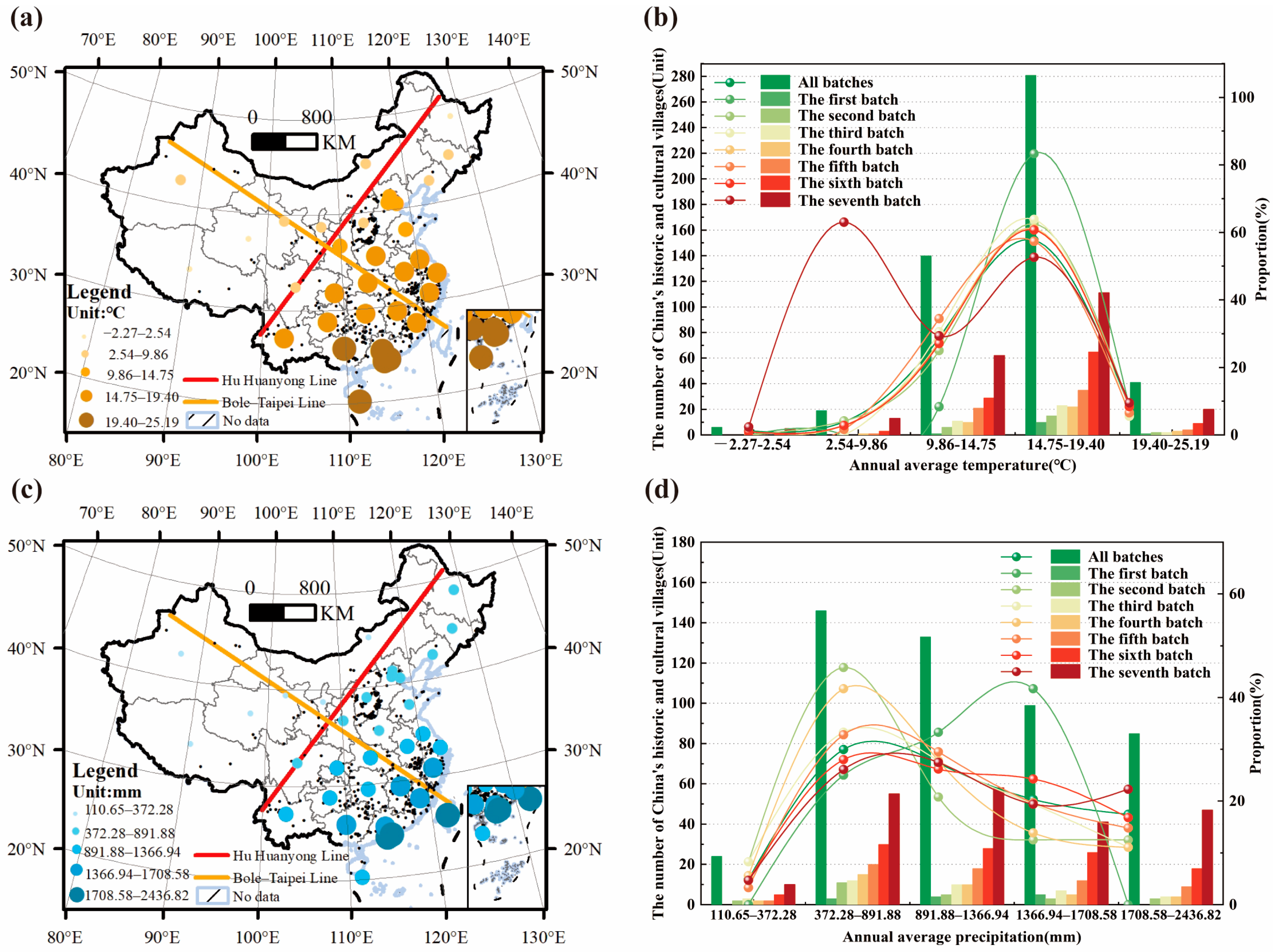
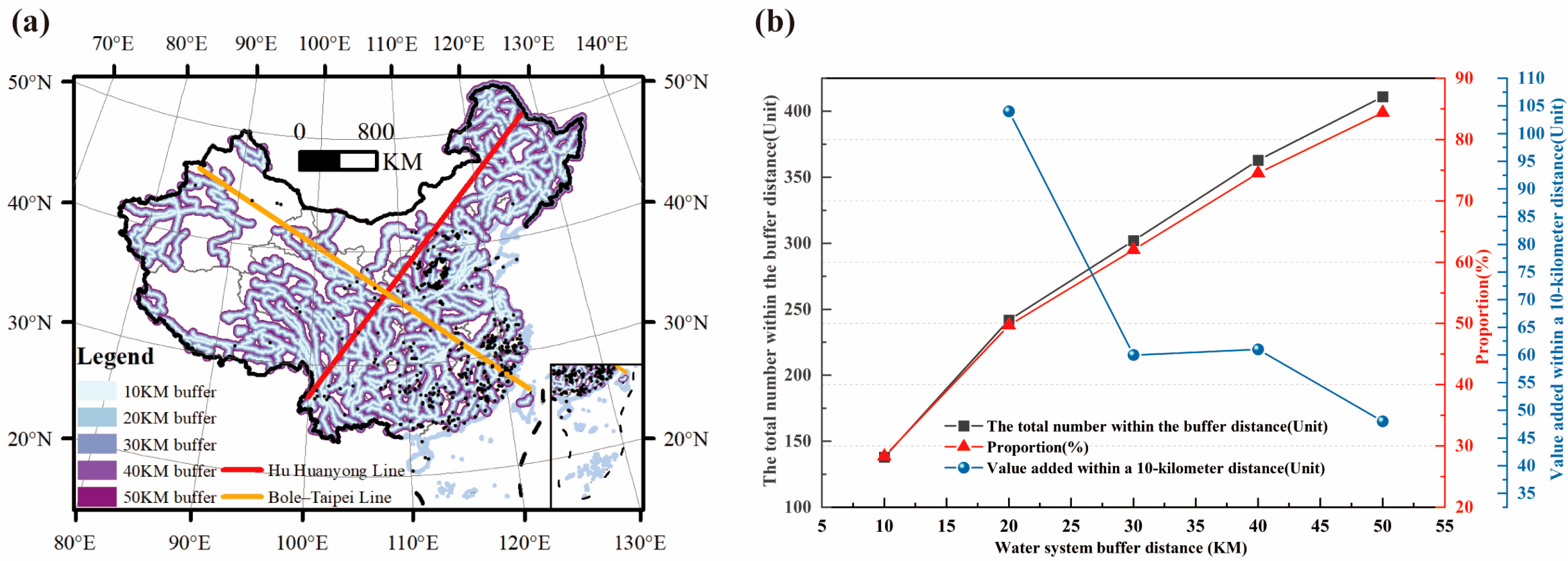
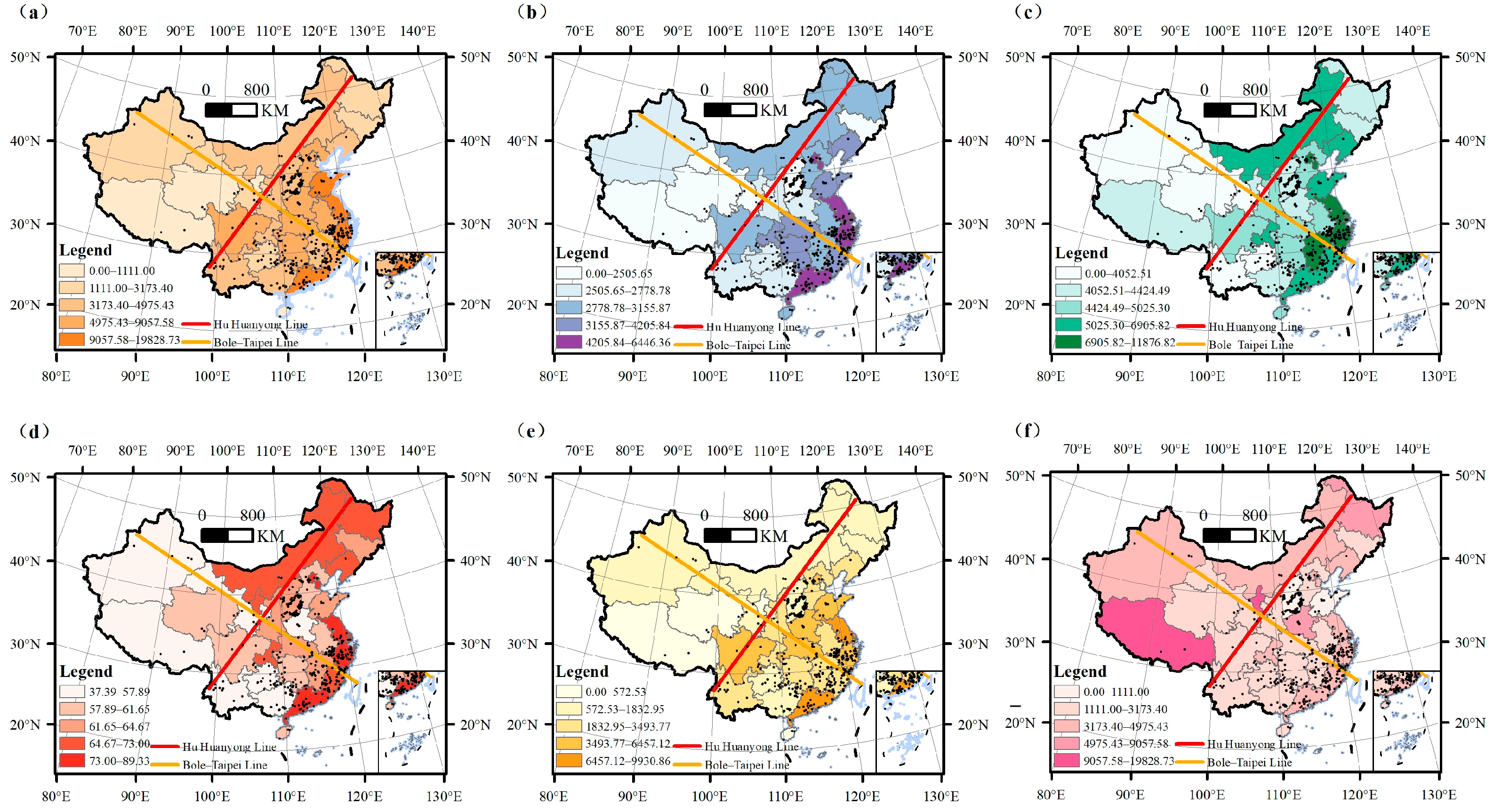
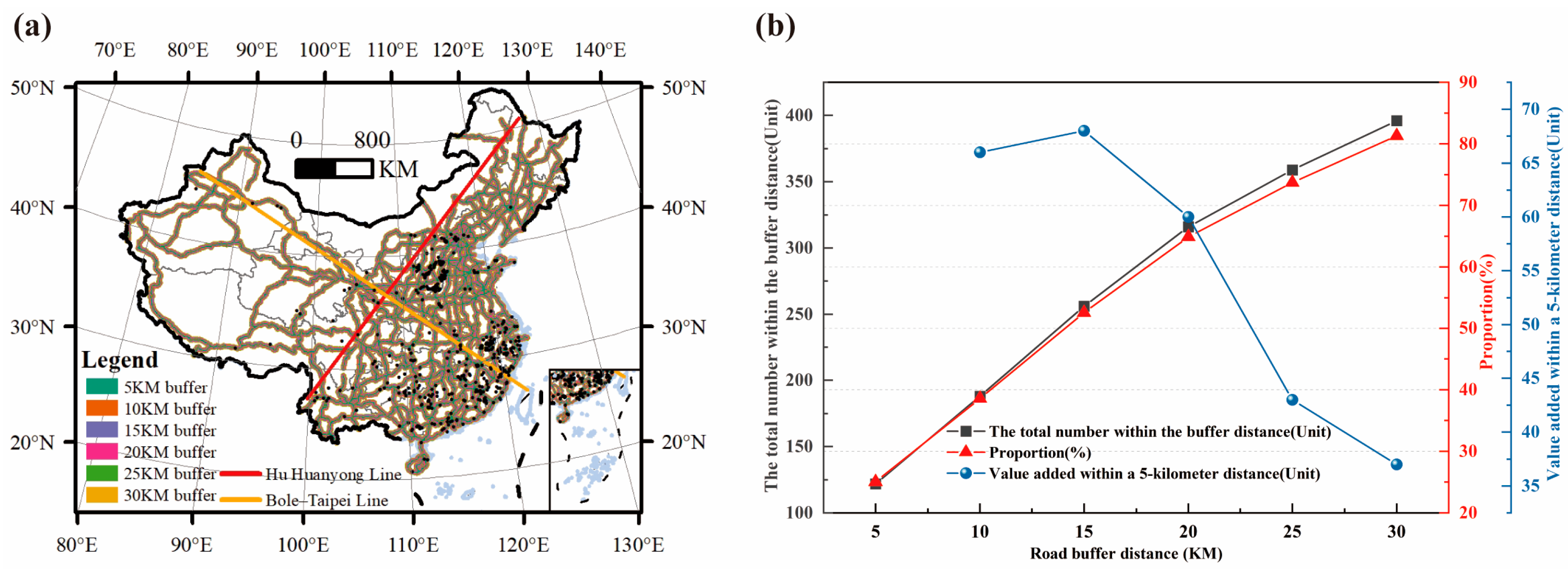
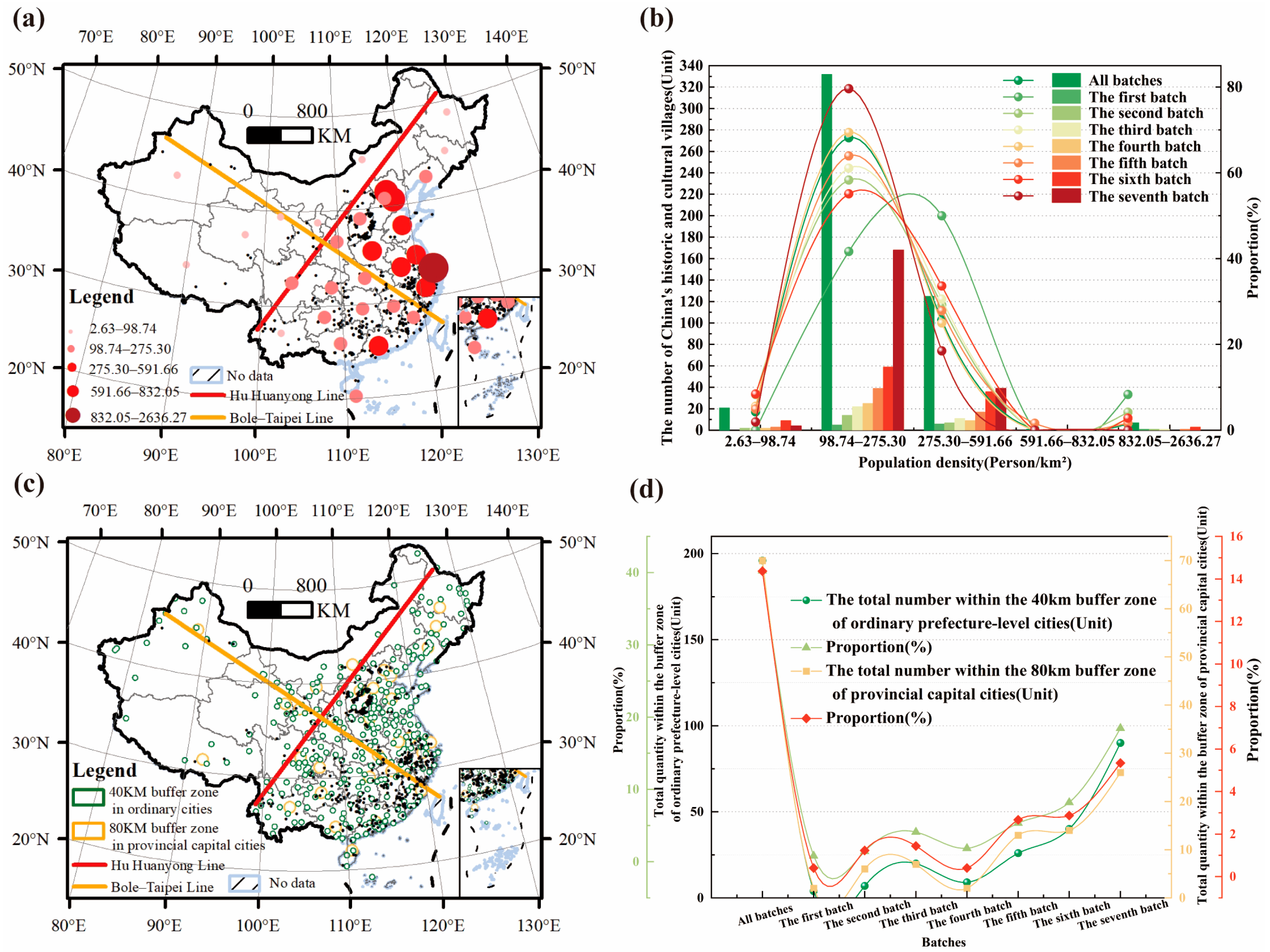
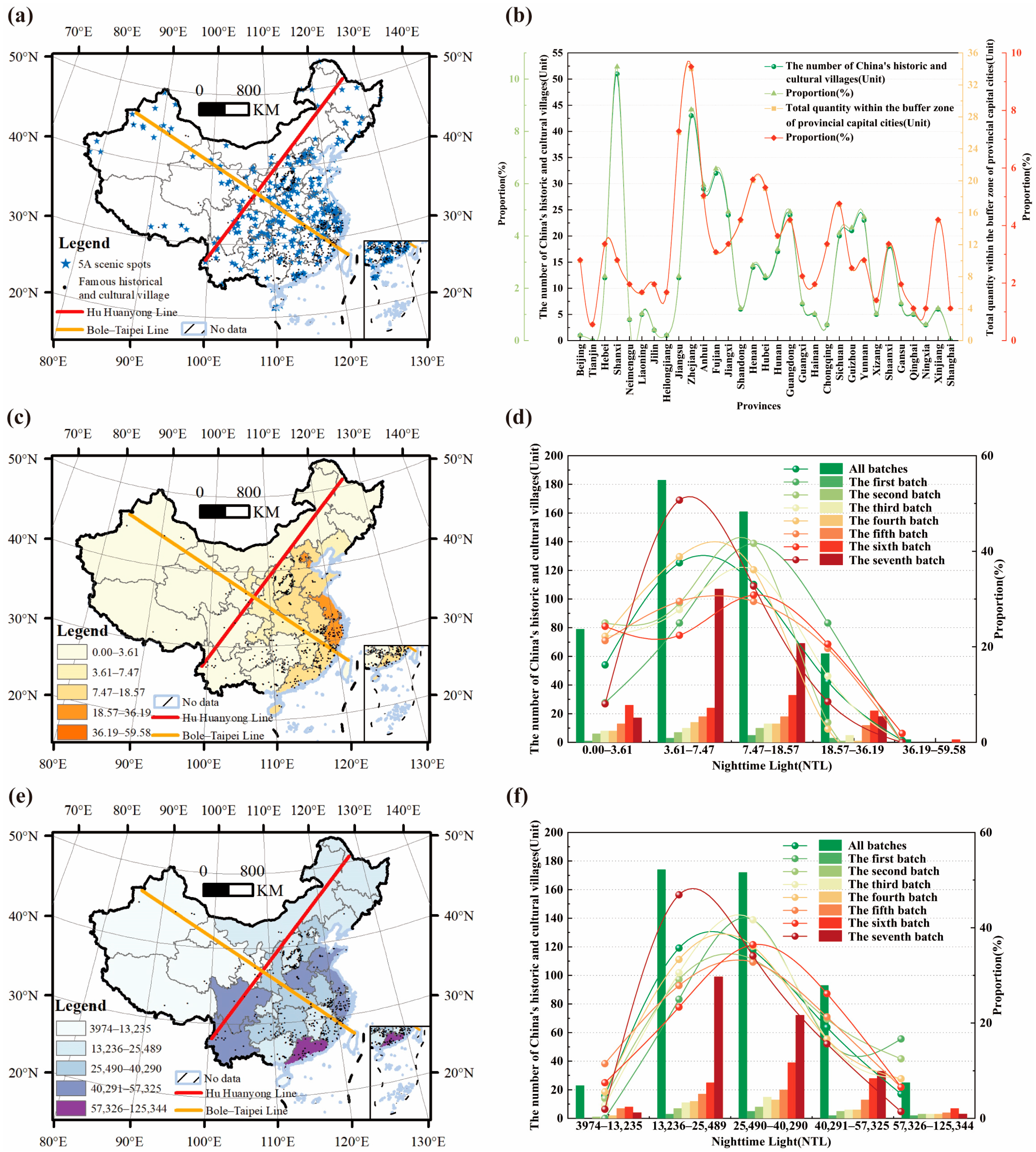
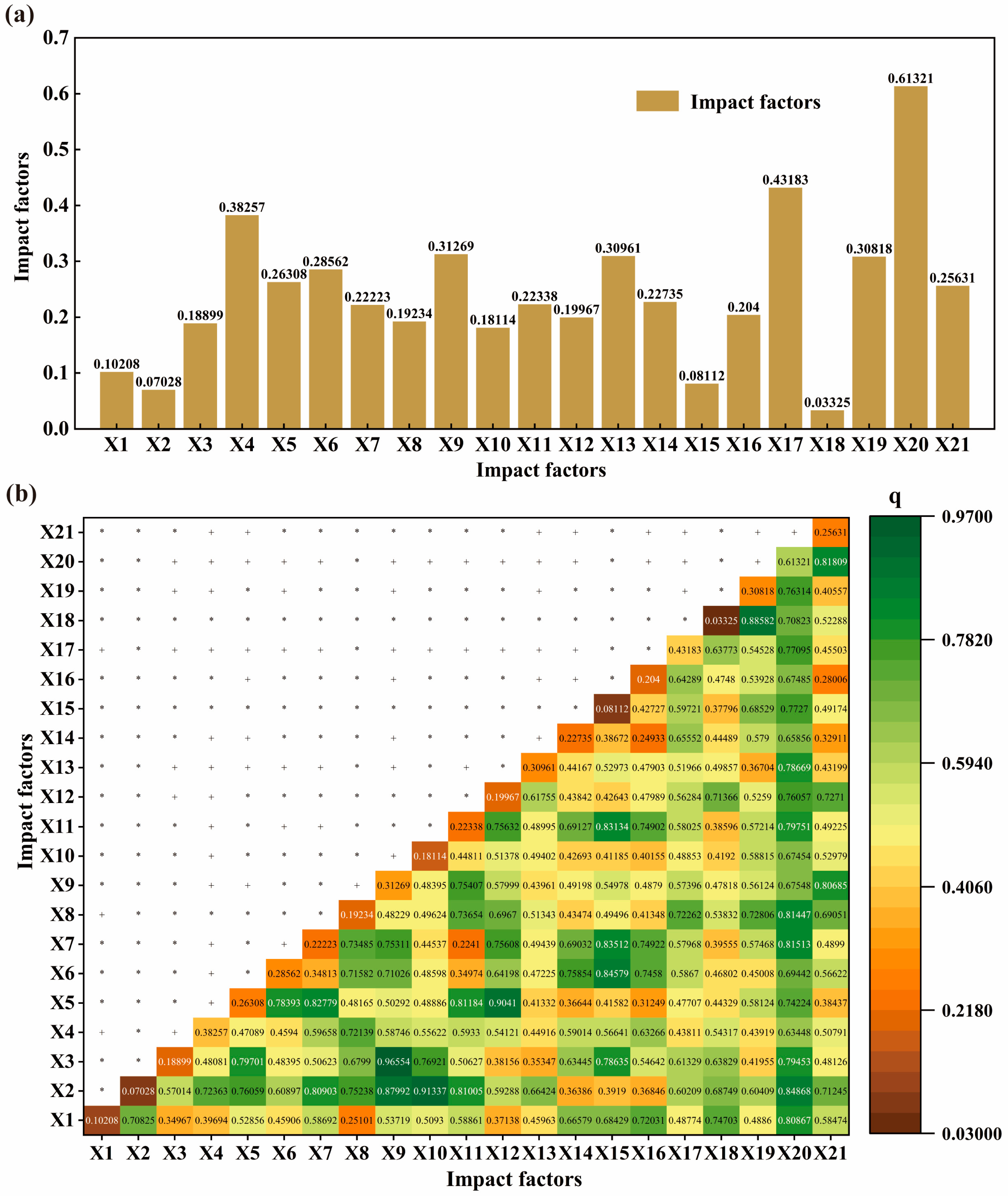
| Data Type | Index | Time | Spatial Resolution | Usage | Source |
|---|---|---|---|---|---|
| Vector data | Base map of administrative boundaries in China | 2024 | — | — | Natural resources Standard map service website [29] |
| River system | 2024 | — | Analysis of distance between villages and river system | National geographic information resources directory service system [30] | |
| National highway | 2024 | — | Analysis of distance between villages and national highway | Open Street Map (OSM) is an open source platform [31] | |
| Vector point data of 5A-rated tourist attractions | 2024 | — | Used to explore driving factors | Ministry of Culture and Tourism of the People’s Republic of China website [32] | |
| Raster data | DEM | 2024 | 30 m | Regional topographic analysis | Geospatial data cloud platform [33] |
| Statistical data | Annual average temperature (°C), annual average precipitation (mm), GDP (US dollars), per capita disposable income of residents (US dollars), per capita consumption expenditure of residents (US dollars), urbanization rate (%), added value of the tertiary industry (US dollars), number of transportation service facilities (units), mileage of graded highways (km), road passenger volume (ten thousand people), railway passenger volume (ten thousand people), population Density (per 10,000 people/km2), annual average lighting value of the province (lux), number of accommodation service facilities (units) | 2024 | — | Used to explore driving factors | China Statistical Yearbook, Statistical Yearbook of provincial administrative Regions, Statistical Bulletin of National Economic and Social Development |
| Driving Factors | Index | Index Interpretation | Unit |
|---|---|---|---|
| Natural Geography [38] | Elevation | Average elevation of each province (X1) | m |
| Slope | Average slope of each province (X2) | ° | |
| Aspect | Average aspect of each province (X3) | ° | |
| Temperature | Annual average temperature of each province (X4) | °C | |
| Precipitation | Annual average precipitation of each province (X5) | mm | |
| River Systems | Average shortest distance from historical and cultural famous villages to water systems of Grade III or above in China (X6) | m | |
| Socioeconomic Conditions [40] | Economic development level | Total GDP of each province (X7) | USD |
| Residents’ consumption capacity | Per capita consumption expenditure of residents (X8) | USD | |
| Residents’ income capacity | Per capita disposable income of residents (X9) | USD | |
| Urbanization level | Urbanization rate (X10) | % | |
| Economic development level of the tertiary industry | Added value of the tertiary industry (X11) | USD | |
| Annual tourism revenue | Annual tourism revenue of each province (X12) | USD | |
| Transportation Accessibility [41] | Number of transportation service facilities | Number of transportation service facilities in each province (X13) | unit |
| Highway passenger volume | Highway passenger volume of each province (X14) | Ten thousand people | |
| Mileage of classified highways | Mileage of classified highways in each province (X15) | km | |
| Railway passenger volume | Railway passenger volume of each province (X16) | Ten thousand people | |
| Tourist Market [42] | Population size | Population density (X17) | Person/km2 |
| Distance from tourist source areas | Average shortest distance from historical and cultural famous villages to the nearest administrative city (X18) | m | |
| Tourism Resources [43] | High-A-grade tourist attractions | Number of 5A-grade tourist attractions (X19) | unit |
| Nighttime lighting construction | Annual average nighttime light intensity of each province (X20) | Lux | |
| Number of accommodation service facilities | Number of accommodation service facilities in each province (X21) | unit |
| Groups | Mean ± Standard Deviation | t | df | p |
|---|---|---|---|---|
| Southeast of the Hu Huanyong Line | 0.80 ± 0.75 | 4.814 | 23.731 | 0.000 ** |
| Northwest of the Hu Huanyong Line | 0.04 ± 0.05 | |||
| Northeast of the Bole–Taipei Line | 0.92 ± 0.77 | 3.636 | 22.510 | 0.001 ** |
| Southwest of the Bole–Taipei Line | 0.22 ± 0.26 |
| Batch | Length/km | Angle/° | Central Coordinate | ||
|---|---|---|---|---|---|
| X-Axis | Y-Axis | Longitude | Latitude | ||
| All batches | 738.7521 | 863.7777 | 158.2101 | 82°10′45″ E | 33°06′14″ N |
| The first batch | 1007.848 | 3208.912 | 164.6658 | 100°47′05″ E | 32°05′21″ N |
| The second batch | 794.0127 | 1019.253 | 150.121 | 63°23′18″ E | 34°00′39″ N |
| The third batch | 655.7251 | 873.9025 | 4.860258 | 85°17′03″ E | 32°29′04″ N |
| The fourth batch | 732.428 | 869.1536 | 138.2787 | 69°34′35″ E | 32°33′58″ N |
| The fifth batch | 760.965 | 1018.645 | 137.6938 | 79°35′29″ E | 32°06′02″ N |
| The sixth batch | 952.6357 | 705.0286 | 83.77808 | 81°49′45″ E | 31°51′08″ N |
| The seventh batch | 571.8203 | 863.9599 | 169.0663 | 85°37′56″ E | 34°04′25″ N |
Disclaimer/Publisher’s Note: The statements, opinions and data contained in all publications are solely those of the individual author(s) and contributor(s) and not of MDPI and/or the editor(s). MDPI and/or the editor(s) disclaim responsibility for any injury to people or property resulting from any ideas, methods, instructions or products referred to in the content. |
© 2025 by the authors. Licensee MDPI, Basel, Switzerland. This article is an open access article distributed under the terms and conditions of the Creative Commons Attribution (CC BY) license (https://creativecommons.org/licenses/by/4.0/).
Share and Cite
Jiang, S.; Lu, N.; Zhang, Z.; Pan, H.; Lu, G.; Sheng, S. Spatiotemporal Distribution and Driving Factors of Historic and Cultural Villages in China. Buildings 2025, 15, 3507. https://doi.org/10.3390/buildings15193507
Jiang S, Lu N, Zhang Z, Pan H, Lu G, Sheng S. Spatiotemporal Distribution and Driving Factors of Historic and Cultural Villages in China. Buildings. 2025; 15(19):3507. https://doi.org/10.3390/buildings15193507
Chicago/Turabian StyleJiang, Shuna, Naigao Lu, Zhongqian Zhang, Huanli Pan, Guoyang Lu, and Shuangqing Sheng. 2025. "Spatiotemporal Distribution and Driving Factors of Historic and Cultural Villages in China" Buildings 15, no. 19: 3507. https://doi.org/10.3390/buildings15193507
APA StyleJiang, S., Lu, N., Zhang, Z., Pan, H., Lu, G., & Sheng, S. (2025). Spatiotemporal Distribution and Driving Factors of Historic and Cultural Villages in China. Buildings, 15(19), 3507. https://doi.org/10.3390/buildings15193507







